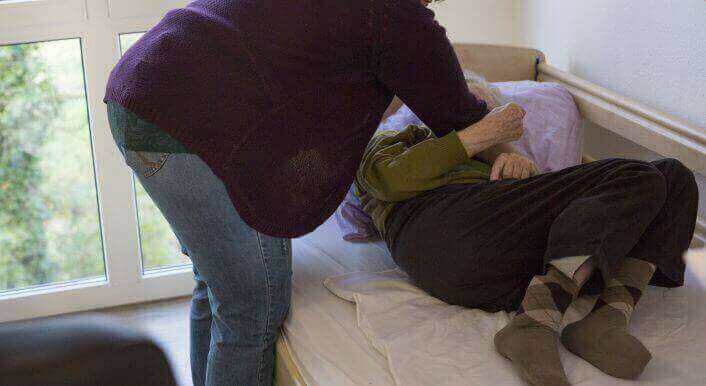How We Created the CORRECTIV Care Guide
A look at how we developed our care guide, as well as information on how you can help us make the current situation more transparent in nursing homes.

How many residents should a nurse have to take care of? How properly is he or she trained? Do they make technical mistakes? How much does the licensee spend for meals? Does the company display high profits – and therefore is less money available for the care for residents?
We don’t know the answers to these questions, although we believe everyone should know these things in order to estimate the quality of a nursing home properly. But the data won’t be published.
On the other hand there is a lot of publicly available data, which can help citizens get an idea of the situation in nursing homes. We’ve collected, researched and analyzed them. Together with Norddeutscher Rundfunk (NDR) we’ve made a film, written a book about the subject and created a website: the CORRECTIV Care-Guide. It’s the first comprehensive journalistic guide of nursing homes in Germany.
What kind of data is available?
For the CORRECTIV Care-Guide, we’ve used the data collected by Medizinischer Dienst der Krankenkassen (MDK) during their annual examination of nursing homes. The federal association of AOK provided us these data in well structured XML-files.
From this data, we used a computer program to generate a short text for every single nursing home. We also selected which health insurance companies, supervision authority and MDK district are responsible for particular homes. If you have questions or complaints, you can contact them directly through the platform.
Additionally, we are using the homes transparency reports which are often criticized because they mainly examine formalities. This may lead to distortion as nursing homes are able to counterbalance poor nursing and medical care with a well-readable meal menu and a nicely-shaped garden. Nationally, on average, homes in Germany are evaluated with a 1.2 – a straight A – and many homes advertise their meaningless grade.
Our own criteria for deficits in nursing homes
We took the 77 criteria behind this overall score and took five important areas for examination and analyzed them. The following 17 questions come from the examination report of the MDK. These are the criteria we used for our evaluation.
1) Care of bedsores
- Is the individual decubitus risk recorded?
- Are necessary decubitus treatments carried out?
- Are the measures of treatment of chronic traumas or decubitus based on current state of knowledge?
- Is the report of the treatment of chronic traumas or decubitus being evaluated properly and is the doctor updated correctly?
2) Nutrition and water supply
- Are individual nutrition risks recorded?
- In cases where the patient is limited in self-care for nutrition supplies, are the risks measured and necessary measures carried out?
- Is the state of nutrition appropriate within the framework of the home’s possibility?
- Are necessary measures carried out if the patient is limited in self-hydration?
3) Pain patients
- Does a systematic evaluation of pain take place?
- In cases where a patient is in pain, does the nursing home work closely with the attending doctor?
- Do residents suffering from chronic pain receive prescribed medicine?
4) Incontinent patients
- Are individual risks and resources of residents with enuresis who have catheters recorded?
- Are necessary measures taken for residents with enuresis by using catheters?
5) Medical supply and medical order
- Does the implementation of treatment measures correlate with medical orders?
- Does the medical supply correlate with medical orders?
- Does the required medication correlate with medical orders?
- Is the handling of medicine appropriate?
The criteria chosen by CORRECTIV are geared from recommendations taken from the evaluation report commissioned by the self-administration for rating the nursing transparency agreement from 2010. In the past similar recommendations were also given by the GKV-Spitzenverband and the MDS (medical service of the head organization of the federal association of health insurances). CORRECTIV also talked to many nurses and experts about the inspections and the chosen criteria.
We decided to use a reduced model, where only the most important criteria from the area one, on nursing and medical supply, are integrated in the analysis. We focused on these criteria, as according to experts they may be a key sign to show quality of care in particular nursing homes.
For the inspection, in every nursing home the controller randomly chooses up to nine people, which he then examines. On average, 72 residents are living in German nursing homes. As a result, a random sample of MDK-examinations is small and lacking full information.
Our five criteria for examination are also based on the same data as the nursing grades. The examinations methodical flaws therefore are persistent. As the authors of the evaluation report in 2010 noticed, the majority of criteria represents the quality of processes, for example the documentation of the care. But experts agree that the quality of results in nursing homes should be tested. Our analysis can’t solve this problem.
If you want to read further: Prof. Klaus Wingenfeld wrote about this subject.
On the whole, the examinations can only give an indication of shortcomings and serve as a suggestion for people to inquire more about their homes in their area.
Nursing home prices and additional data
The AOK insurance company also gave us additional data on every nursing home, including the price for care in every nursing home, how many people these homes host and if it’s run by a private company, a non-profit or a public institution. We compared the prices and the beds of the different homes in relation to other homes.
As for the prices, we use the part the inpatients have to pay for themselves for the care in care-level 3 for a full month. This differs a lot, from less than 1000 to more than 2000 Euro per month. On top of this, the patients have to pay so-called investment costs, which differs as well and can often be around 500 Euro per month. We wanted to include these costs in our analysis as well, but for most of the homes the AOK did not hand us clear data, but rather a possible range of the investment cost from minimum to maximum. Therefore we weren’t able to use this number and publish the cost without the additional investment cost.
We compared the price of every nursing home to the average price of nursing homes in the same state. We did not compare it to the average national price because the prices between the different states differ a lot. We grouped the price into five parts: very expensive, expensive, moderately priced, cheap, and very cheap. The cheapest 20 percent is labeled as very cheap.
For the data on beds, we also used the AOK data and compared the number of occupied beds with other homes. This time we compared the number to the national average because the numbers are more homogenous and there are (almost) no state regulations that affect the number of beds in nursing homes. Again we grouped the numbers into five parts very big, big, normal-sized, small, and very small. The smallest 20 percent is labeled as very small.
The description of the data (prices, beds, grades) and the automatically generated 13,000 texts are not a product of our own judgement, but only an analysis of the data of the transparency reports. We compare the numbers to other homes to make it easier for people to understand them, but we do not judge the numbers. That would not be possible for 13,000 nursing homes as we don’t have complete data for all of them.
Secret reports on staff rate
Besides the public transparency report data we used for our guide, the MDK creates a detailed report on every single nursing home.
We’ve asked all 16 medical services of health insurances (MDK) for these detailed reports. All 16 refused to give them to us and referred to § 115 XI paragraph 1 saying: „Facing a third party the examiners and receivers of data are sworn to secrecy.“ We think this is wrong. These data should be published.
Reports by the supervision authorities – different, often secret
We also collected information from several state-controlled Heimaufsichten (nursing home supervision authorities). The Heimaufsicht is organized differently in every federal state. To some extent the federal government is responsible, to some extent it’s regional boards or local authorities themselves. In addition to MDK, the authorities control the homes each for one or two years and are able to undertake „occasional examinations“ after complaints and can close a nursing home that violates conditions.
Some nursing home authorities publish their reports online. But many of them are simplified or misleading. Other authorities keep their reports a secret. We’ve contacted the nursing home supervisions in all federal states. But we can only publish reports from eight federal states. These are: Bayern, Berlin, Bremen, Mecklenburg-Vorpommern, Nordrhein-Westfalen, Rheinland-Pfalz, Sachsen-Anhalt and Schleswig-Holstein.
For the federal states that do not publish their reports online, we provided example reports and published them on our platform. All other reports are at first not publicly available. That’s where we need your help.
For every nursing home, we provide a link to our partner-website, FragDenStaat.de. Click on the particular link, then our website will generate an automatic request according to the German freedom of information act.
Through this, you can request the examination report for your nursing home of interest. Every report you requested will be published by us in our guide. The more you take part, the more supervision reports we are able to publish publicly and the more transparent nursing homes will get.
We’ve created hints and a checklist in our guidebook, but also other webpages with information on nursing homes and a long list with contact information to helpful organizations.
For those interested in wanting more background and why there are such severe problems in German nursing homes, you can order our book: „Jeder pflegt allein – Wie es in deutschen Heimen wirklich zugeht“ or „Everyone cares alone. What really happens in German nursing homes.“
Stefan Wehrmeyer contributed to this investigation.



